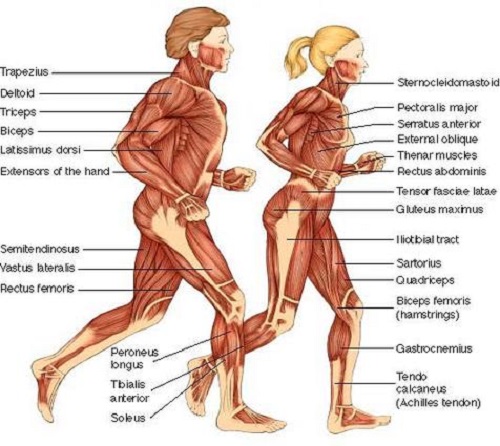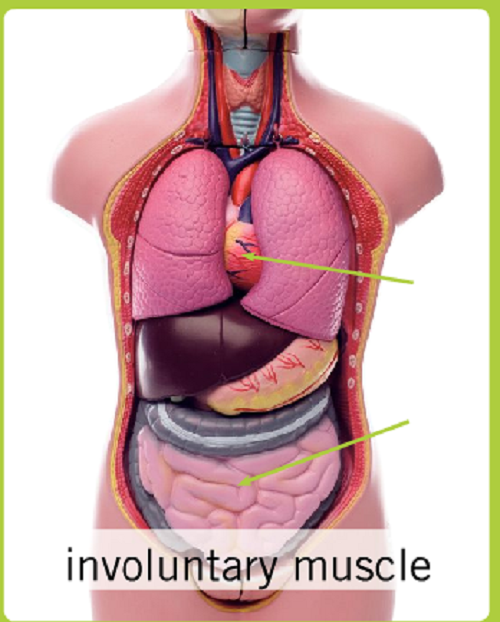Difference between Voluntary and Involuntary Muscles
What is Voluntary Muscle?
Voluntary muscles are those which are under conscious control, which means under the control of the somatosensory nervous system.
This includes the skeletal muscles that attach to the bones and skin. The skeletal muscles allow the body to move by contracting and relaxing against bones and skin. They also maintain posture in the body. They attach to bones by connective tissue called tendons.
- Skeletal muscle cells are long cells that appear striated. They are also multinucleated.
The cells have several nuclei located in cytoplasm known as the sarcoplasm. The nuclei are found only on the edges of the cell.
The muscle cells are arranged into bundles of muscle fibers. These bundles of fibers are arranged lengthwise and surrounded by a sheath of connective tissue to form the muscle.
They have contractile units called sarcomeres which shorten causing the muscle to contract, and then lengthen causing the muscle to relax.
Actin and myosin proteins are arranged in a specific way to form these sarcomeres. It is the action of these proteins sliding past each other which brings about the contraction of the muscle. This is called the sliding filament theory of muscle contraction.
Contraction involves other proteins such as tropomyosin and troponin which works with the actin and myosin to bring about movement.
Individual sarcomeres are separated at the Z disc, which is the junction between different cells.
Skeletal muscle contains protein myofilaments that are aligned in a specific way.
Skeletal muscle can contract quickly but it also tires quickly.
Skeletal muscles have an origin and an insertion which are the points of attachment.
They often work in pairs, in an antagonistic fashion. There are two main types of antagonistic muscles:
- extensors (extend) and flexors (flex),
- abductors (move limbs away from the center of the body) and adductors (move limbs towards the center of the body).
What is Involuntary Muscle?
Involuntary muscle is under unconscious control, which means under the control of the autonomic nervous system.
These muscles contract without us being aware of it.
Involuntary muscle includes: the smooth muscles that line organs, as well as the cardiac muscle of the heart.
- Smooth muscle cells are tapered at the ends and do not contain striations, they also contain a central nucleus.
These cells contract slowly, and line all the organs of the body, including blood vessels.
The myofilaments of smooth muscle are not aligned in a specific way but rather are scattered.
They contain actin and myosin, but these are not arranged into sarcomeres. Since they are not as organized as skeletal muscle, the muscles can shorten in more than one direction.
Smooth muscle contracts slowly and tires slowly.
Smooth muscles can be divided into two types:
- Multiunit- occurs in the ciliary body and iris of the eye, walls of blood vessels and arrector pili of body hairs.
- Visceral – occurs in the walls of digestive organs, uterus and several other visceral organs.
- Cardiac muscle cells are striated but shorter than skeletal muscles and have a centrally located nucleus.
The cardiac muscle cells branch and join firmly at structures known as intercalated discs.These intercalated discs ensure that the contraction of heart muscle cells is in synchrony.
Cardiac muscle has powerful contractions that occur repeatedly as part of the cardiac cycle of the heart.
Cardiac muscle does not tire out and is myogenic (does not require an outside nerve stimulus to contract).
What is the difference between Voluntary and Involuntary Muscles?
- Involuntary muscle is under unconscious control while voluntary muscle is under conscious control.
- Voluntary muscle is under the control of the autonomic nervous system while the involuntary muscle is under the control of the somatosensory nervous system.
- Voluntary muscles include skeletal muscle that attaches to bone and skin.
- Involuntary muscle includes smooth muscle that lines organs, and cardiac muscle of the heart.
- While some involuntary muscles (e.g. cardiac muscles) contract in a constant rhythmic cycle, voluntary muscles do not.
- Voluntary muscle contains multinucleated cells, while involuntary muscle is uninucleated.
- Voluntary muscle nuclei are located on the edges of the cell while those of involuntary muscle are located in the center of the cell.
- Voluntary muscle cells are very long while involuntary muscle cells are short.
- Voluntary muscle cells have sarcomeres while involuntary muscle cells do not have sarcomeres.
- Some involuntary muscle cells are joined by an intercalated disc, while voluntary muscle cells join at a Z disc.
- Troponin is present in all voluntary muscle but is present only in some involuntary muscle (cardiac).
- Voluntary muscle tires easily while involuntary muscle does not tire out (cardiac) or tires out very slowly (smooth).
Table comparing Voluntary and Involuntary Muscles
| Voluntary | Involuntary |
| Conscious control | Unconscious control |
| Somatosensory nervous system | Autonomic nervous system |
| Skeletal muscle | Not skeletal muscle |
| Not cardiac and smooth muscle | Cardiac and smooth muscle |
| None have constant rhythmic contractions | Some have constant rhythmic contractions |
| Multinucleated cells | Uninucleated cells |
| Nuclei in edge of cell | Nuclei at center of cell |
| Long cells | Short cells |
| Have sarcomeres | Have no sarcomeres |
| Z discs | No Z discs, some with intercalated discs |
| Troponin in all types | Troponin only in some types |
| Muscle tires easily | Muscle tires slowly or not at all |
Summary:
- Voluntary muscles include the muscles attached to the skeleton.
- The involuntary muscles include smooth and cardiac muscles.
- Smooth muscles line the organs, while cardiac muscle forms the heart.
- Voluntary muscle is under conscious control, and thus is controlled by the somatic nervous system while the involuntary muscle is under unconscious control, controlled by the autonomic nervous system.
- Voluntary muscle cells are long, multinucleated cells that contain sarcomeres and are arranged into bundles.
- Involuntary muscle cells are striated and branched in the case of cardiac muscle.
- The other type of involuntary muscle, smooth muscle is not striated and consists of spindle-shaped short cells.
- There are different types of smooth muscles and skeletal muscles.
- The structure of voluntary and involuntary muscles matches their functions in the human body.
- Difference Between Rumination and Regurgitation - June 13, 2024
- Difference Between Pyelectasis and Hydronephrosis - June 4, 2024
- Difference Between Cellulitis and Erysipelas - June 1, 2024
Search DifferenceBetween.net :
5 Comments
Leave a Response
References :
[0]Dorit, Robert L, Warren F. Walker, and Robert D. Barnes. Invertebrate Zoology. Philadelphia: Saunders College Publishing, 1991. Print.
[1]Kilgour, O.F.G. Mastering Biology. London: MacMillan Press, 1982. Print.
[2]Rye, Connie, Robert Wise, Vladimir Jurukovski, Jean DeSaix, Jung Choi, and Yael Avissar. Biology. Houston: Rice University, 2017. Print
[3]"Image Credit: http://healthsciencetechnology.wikispaces.com/Muscular+System"
[4]"Image Credit: http://sgaguilarjramos.blogspot.in/2012/10/internal-coordination-in-our-body.html"



I really liked the answer given….
Amazing explaination!!!!!
Success more dear!!!!!
Really wonderful and exemplary answer……..
Carry on….
And keep it up!
awsome fact
This made m understand very clearly…I liked…tq fr info….keep going on….do ur bst so that we people can understand very esay.. clearly….deeply
Nice information
Really awesome answer